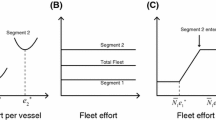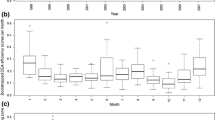Abstract
We use a stochastic production frontier model to investigate the presence of heterogeneous production and its impact on fleet capacity and capacity utilization in a multi-species fishery. We propose a new fleet capacity estimate that incorporates complete information on the stochastic differences between vessel-specific technical efficiency distributions. Results indicate that ignoring heterogeneity in production technologies within a multi-species fishery as well as the complete distribution of a vessel’s technical efficiency score, may lead to erroneous fleet-wide production profiles and estimates of capacity. Our new estimate of capacity enables out-of-sample production predictions which may be useful to policy makers.


Similar content being viewed by others
Notes
Ad hoc approaches such as the “peak to peak” method have been used in the past, which prompted many authors to discuss their limitations and suggest more rigorous methodologies.
This is an oversimplification of the current state of the literature, but our purpose is not to discuss the relative merits of DEA and SPF models.
This is true if we assume that fishermen do not alter their technological choice or targeting strategies for output, measured as the assemblage of species caught within the fishery. Changes in regulatory measures will have many implications on people’s choice sets for inputs and outputs, which will not only reflect technological production possibilities, but also other factors not captured by the production function.
A vessel’s age is recorded but vessels are often refurbished and using their build dates to indicate the vintage of their technology is often times erroneous.
A random coefficients stochastic frontier model has been developed by Greene (2005).
In the sequel we augment the production function with a random error term, independent of efficiency.
This may not be true if a vessel is very inefficient and expending a lot of effort for their size. In this case the capacity utilization score could be high, and \( Y_{it|j}^{MAX} \) could be less than \( Y_{it|j}^{TE} . \)
These capacity estimates do not allow vessels to increase the number of weeks they fish each year, only the number of days they fish within the weeks observed. Therefore, our estimates of capacity may be biased downward. However, the relative comparisons of the different capacity estimates, including the new estimator we propose, will not be compromised by this assumption.
There are a number of issues that must be addressed when defining capacity measures. For a more detailed discussion of these issues see Kirkley et al. (2002).
Alternatively, we could estimate capacity utilization \( Y_{it|j}^{TE} / Y_{it|j}^{TE,MAX} \) as proposed by Fare et al. (1998) which is ‘unbiased’ because it is not directly influenced by technical inefficiency.
In addition, these vessels catch a fair amount of Pacific cod and pollock. These species compose about 8% and 6% of the total retained catch, respectively. However, we exclude them from the analysis since they are considered bycatch.
We focus on retained catch in our analysis instead of total catch, since we believe it more closely reflects the targeting practices of the fleet. In the case that the retained amount of yellowfin sole was zero we substituted in a value of 0.0001 metric tons to facilitate the log-transformation of the production variables.
We also investigated using each vessel’s horsepower but due to multicollinearity concerns it was eliminated.
Given that both Duration and Days are definitions of time, it is important to note that the linear correlation is only 0.75, which is not as high as one may hypothesize. This is because duration is a time input relating to product quality, the captain’s ability to locate fish, and the processing technology used on board the vessel. Days, on the other hand, is a temporal input determine how long the vessel stays at sea and is influenced by the vessels hold capacity, freezing capacity and how fast the holds are filled.
A referee pointed out that the latent variable model assumes that vessels remain in their classes, so any vessel switching across production classes may call into question the validity the analysis.
Dummy variables within this framework can be problematic, for it is possible for a given dummy variable to be unvarying within a given segment.
Initial investigations used S t , but it was statistically insignificant and highly collinear with the constant term due its relative stability throughout the period studied.
Our criterion for this selection was a collinearity estimate of 0.9 or greater.
Restrictions on the coefficients were not implemented a priori, curvature restrictions were tested following estimation.
Estimation results assuming J = 2 are available upon request from the author(s).
The crAIC is −2ln(L) + G*(2 + (2*(G + 1)*(G + 2))/(N − G−2)) and the BIC is −2ln(L) + G(ln(N)), where G is the number of parameters estimated in the model and N is the number of vessels in the fishing fleet.
Another commonly used measure is the conditional expectation of exp{− u i|j }, but this is simply a monotonic transformation of the conditional mean used here. Therefore, they are essentially the same for the purposes of comparative analysis and policy evaluation.
References
Aigner DJ, Lovell AK, Schmidt P (1977) Formulation and estimation of stochastic frontier production models. J Econom 6:21–37. doi:10.1016/0304-4076(77)90052-5
Alvarez A, Schmidt P (2006) Is skill more important than luck in explaining fish catches? J Prod Anal 26:15–25. doi:10.1007/s11123-006-0002-x
Anderson CM, Putterman L (2006) Do non-strategic sanctions obey the law of demand? The demand for punishment in the voluntary contribution mechanism. Games Econ Behav 54:1–21
Battese GE, Coelli TJ (1988) Prediction of firm-level technical efficiencies with a generalized frontier production function and panel data. J Econom 38(3):387–399. doi:10.1016/0304-4076(88)90053-X
Battese GE, Coelli TJ (1995) A model for technical inefficiency effects in a stochastic frontier production function for panel data. Empir Econ 20:325–332. doi:10.1007/BF01205442
Battese GE, Coelli TJ, Colby TC (1989) Estimation of frontier production functions and the efficiencies of Indian farms using panel data from ICRISAT’s village level studies. J Quant Econ 5(2):327–348
El-Gamal M, Grether D (1995) Are people bayesian? uncovering behavioral strategies. J Am Stat Assoc 90:1137–1145. doi:10.2307/2291506
El-Gamal M, Grether D (2000) Are people Bayesian? Uncovering behavioral strategies using estimation classification (EC). In: Machina M et al (eds) Preferences, beliefs, and attributes in decision making. Kluwer, New York
El-Gamal M, Inanoglu H (2005) Inefficiency and heterogeneity in Turkish banking: 1990–2000. J Appl Econom 20:641–664. doi:10.1002/jae.835
Fare R, Grosskopf S, Kokkelenberg EC (1989) Measuring plant capacity, utilization and technical change: a nonparametric approach. Int Econ Rev 30:655–666. doi:10.2307/2526781
Felthoven RG (2002) Effects of the American Fisheries Act on capacity, utilization and technical efficiency. Mar Resour Econ 17(3):181–205
Felthoven RG, Paul CJM (2004) Mutli-output, nonfrontier primal measures of capacity and capacity utilization. Am J Agric Econ 86(3):619–633. doi:10.1111/j.0002-9092.2004.00605.x
Flores-Lagunes A, Horrace WC, Schnier KE (2007) Identifying technically efficient fishing vessels: a non-empty, minimal subset approach. J Appl Econ 22:729–745. doi:10.1002/jae.942
Food and Agriculture Organization (1998) Report of the technical working group on the management of fishing capacity. FAO fisheries report number 586. Food and Agriculture Organization, Rome
Garcia de Hoyo JJ, Espino DC, Toribio RJ (2005) Determination of technical efficiency of fisheries by stochastic frontier models: a case on the Gulf of Cadiz(Spain). ICES J Mar Sci 61:417–423
Greene WH (2005) Reconsidering heterogeneity and inefficiency: alternative estimators for stochastic frontier models. J Econom 126(2):269–303. doi:10.1016/j.jeconom.2004.05.003
Guyader O, Daures F, Fifas S (2004) A bioeconomic analysis of the impact of decommissioning programs: application to a limited-entry French scallop fishery. Mar Resour Econ 19:225–242
Horrace WC (2005) On ranking and selection from independent truncated normal distributions. J Econom 126:335–354. doi:10.1016/j.jeconom.2004.05.005
Kirkley J, Squires D, Strand IE (1998) Characterizing managerial skill and technical efficiency in a fishery. J Prod Anal 9:145–160. doi:10.1023/A:1018308617630
Kirkley J, Fare R, Grosskopf S, McConnell K, Squires D, Strand I (2001) Assessing capacity and capacity utilization in fisheries when data are limited. North Am J Fish Manag 21:482–497. doi:10.1577/1548-8675(2001)021<0482:ACACUI>2.0.CO;2
Kirkley J, Morrison Paul C, Squires D (2002) Capacity and capacity utilization on common-pool resource industries: definition measurement and a comparison of approaches. Environ Resour Econ 22:77–97. doi:10.1023/A:1015511232039
Kirkley J, Squires D, Alam MF, Ishak HO (2003) Excess capacity and asymmetric information in developing country fisheries: the Malaysian purse seine fishery. Am J Agric Econ 85(3):647–662. doi:10.1111/1467-8276.00462
Kirkley J, Morrison-Paul C, Cunningham S, Catanzano J (2004) Embodied and disembodied technical change in fisheries: an analysis of the Sete trawl fishery, 1985–99. Environ Resour Econ 29:191–217. doi:10.1023/B:EARE.0000044603.62123.1d
Kompas T, Che TN (2005) Efficiency gains and cost reductions form individual transferable quotas: a stochastic cost frontier for the Australian South East fishery. J Prod Anal 23:285–307. doi:10.1007/s11123-005-2210-1
Kompas T, Che TE, Grafton QR (2004) Technical efficiency effects of input controls: evidence from Australia’s banana prawn fishery. Appl Econ 36:1631–1641. doi:10.1080/0003684042000218561
Meeusen W, van den Broeck J (1977) Efficiency estimation from Cobb-Douglas production functions with composed error. Int Econ Rev 18:435–444. doi:10.2307/2525757
Mistiaen JA, Strand IE (2000) Location choice of commercially fishermen with heterogeneous risk preferences. Am J Agric Econ 82:1184–1190. doi:10.1111/0002-9092.00118
Orea L, Kumbhakar SC (2004) Efficiency measurement using a latent class stochastic frontier model. Empir Econ 29(1):169–183. doi:10.1007/s00181-003-0184-2
Orea L, Alvarez A, Morrison Paul CJ (2005) Modeling and measuring production processes for a multi-species fishery: alternative technical efficiency estimates for the northern Spain hake fishery. Nat Resour Model 18(2):183–213
Pascoe S, Coglan L (2002) The contribution of unmeasurable inputs to fisheries production: an analysis of technical efficiency of fishing vessels in the English Channel. Am J Agric Econ 84(3):585–597. doi:10.1111/1467-8276.00321
Paul CJM, Johnston W, Frengley G (2000) Efficiency in New Zealand sheep and cattle farming: the impacts of regulatory reform. Rev Econ Stat 82:325–337. doi:10.1162/003465300558713
Provencher B, Bishop RC (2004) Does accounting for preference heterogeneity improve the forecasting of a random utility model? A case study. J Environ Econ Manag 48:793–810. doi:10.1016/j.jeem.2003.11.001
Reid C, Squires D, Jeon Y, Rodwell L, Clarke R (2003) An analysis of fishing capacity in the western and central Pacific Ocean tuna fishery and management implications. Mar Policy 27:449–469. doi:10.1016/S0308-597X(03)00065-4
Scarpa R, Thiene M (2005) Destination choice models for rock climbing in the Northeastern Alps: a latent class approach based on intensity of preferences. Land Econ 81(3):426–444
Schnier KE, Anderson CM (2006) Decision making in patchy resource environments: spatial misperceptions of bioeconomic models. J Econ Behav Organ 61:234–254. doi:10.1016/j.jebo.2005.03.014
Sharma KR, Leung PS (1998) Technical efficiency of Hawaii’s longline fishery. Mar Resour Econ 13(4):259–274
Shephard RW (1970) Theory of cost and production functions. Princeton University Press, Princeton
Smith MD (2005) State dependence and heterogeneity in fishing location choice. J Environ Econ Manag 50:319–340. doi:10.1016/j.jeem.2005.04.001
Squires D, Kirkley J (1999) Skipper skill and panel data in fishing industries. Can J Fish Aquat Sci 56:2011–2018. doi:10.1139/cjfas-56-11-2011
Train KE (1998) Recreation demand models with taste differences over people. Land Econ 74:230–239. doi:10.2307/3147053
Train KE (2003) Discrete choice methods with simulation. Cambridge University Press, Cambridge, UK
Viswanathan KK, Omar IH, Jeon Y, Kirkley J, Squires D, Susilowati I (2003) Fishing skill in developing country fisheries: the Kedah, Malaysia trawl fishery. Mar Resour Econ 16:293–314
Weninger Q, Waters JR (2003) Economic benefits of management reform in the northern Gulf of Mexico reef fishery. J Environ Econ Manag 46:207–320. doi:10.1016/S0095-0696(02)00042-6
Author information
Authors and Affiliations
Corresponding author
Rights and permissions
About this article
Cite this article
Felthoven, R.G., Horrace, W.C. & Schnier, K.E. Estimating heterogeneous capacity and capacity utilization in a multi-species fishery. J Prod Anal 32, 173–189 (2009). https://doi.org/10.1007/s11123-009-0139-5
Published:
Issue Date:
DOI: https://doi.org/10.1007/s11123-009-0139-5




